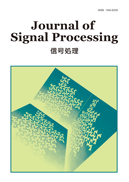21 巻, 6 号
Special Issue on Nonlinear Circuits, Communications and Signal Processing (Editor-in-Chief: Keikichi Hirose, Editor: Yoshikazu Miyanaga, Guest Editor: Masashi Unoki, Honorary Editor-in-Chief: Takashi Yahagi)
選択された号の論文の9件中1~9を表示しています
- |<
- <
- 1
- >
- >|
-
2017 年21 巻6 号 p. 233-238
発行日: 2017/11/15
公開日: 2017/11/15
PDF形式でダウンロード (976K) -
2017 年21 巻6 号 p. 239-247
発行日: 2017/11/15
公開日: 2017/11/15
PDF形式でダウンロード (6829K) -
2017 年21 巻6 号 p. 249-256
発行日: 2017/11/15
公開日: 2017/11/15
PDF形式でダウンロード (1062K) -
2017 年21 巻6 号 p. 257-264
発行日: 2017/11/15
公開日: 2017/11/15
PDF形式でダウンロード (3221K) -
2017 年21 巻6 号 p. 265-272
発行日: 2017/11/15
公開日: 2017/11/15
PDF形式でダウンロード (768K) -
2017 年21 巻6 号 p. 273-279
発行日: 2017/11/15
公開日: 2017/11/15
PDF形式でダウンロード (1688K) -
2017 年21 巻6 号 p. 281-289
発行日: 2017/11/15
公開日: 2017/11/15
PDF形式でダウンロード (1003K) -
2017 年21 巻6 号 p. 291-296
発行日: 2017/11/15
公開日: 2017/11/15
PDF形式でダウンロード (4032K) -
2017 年21 巻6 号 p. 297-308
発行日: 2017/11/15
公開日: 2017/11/15
PDF形式でダウンロード (1623K)
- |<
- <
- 1
- >
- >|
